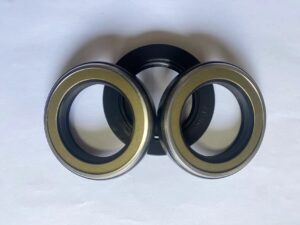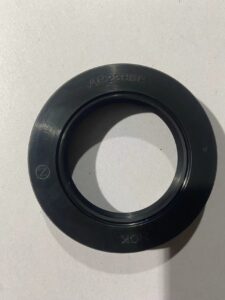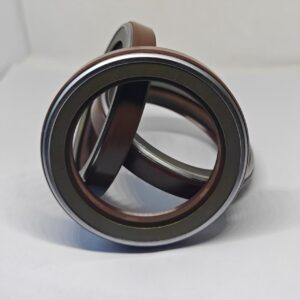Table of Contents
ToggleWhat is a TCN Oil Seal?
A TCN oil seal is a high-performance sealing component designed for applications requiring reliable fluid retention and contaminant exclusion under moderate to high-pressure conditions. Characterized by its robust internal “skeleton” structure and elastomer sealing lip, this seal excels in environments where standard seals might fail. Below is a detailed breakdown of its design, functionality, and industrial significance.



Decoding the “TCN” Designation
While the acronym TCN lacks universal standardization, it is widely interpreted based on its structural and material attributes:
- T: “Tandem” or “Triple” (denoting multi-lip configurations).
- C: “Case” (indicating a metal-reinforced casing or skeleton).
- N: “Nitrile” (referring to Nitrile rubber, the primary elastomer material).
Thus, a TCN oil seal is typically defined as a metal-cased, multi-lipped seal constructed from Nitrile rubber (NBR), often enhanced with a spring mechanism for consistent sealing performance.
Core Design and Construction
The TCN oil seal’s effectiveness stems from its hybrid design, combining rigidity and flexibility:
1. Internal Skeleton Structure
- Metal Reinforcement:
- A rigid internal framework (often steel or aluminum) provides structural integrity, preventing deformation under high pressure (exceeding 10 bar or 145 psi).
- This “skeleton” ensures dimensional stability, isolating lubricated components from external forces.
2. Elastomer Sealing Lip
- Material Options:
- Nitrile (NBR): Offers excellent oil and fuel resistance, with a temperature range of –40°C to 120°C (–40°F to 248°F).
- Hydrogenated Nitrile (HNBR): Enhanced thermal stability (up to 150°C) and chemical resistance.
- Fluoroelastomer (FKM): For high-temperature applications (up to 200°C), though less common due to cost.
- Spring Energization:
- A garter spring or helical coil applies constant radial pressure to the sealing lip, compensating for shaft wear, thermal expansion, or misalignment.
3. Multi-Lip Configuration
- Primary Lip:
- Seals against fluid leakage (oil, grease, or hydraulic fluids).
- Secondary Lip(s):
- Acts as a dust or debris barrier, preventing contaminant ingress.
- Tertiary Lip (Optional):
- Added in harsh environments for redundancy.
Key Functional Advantages
TCN oil seals address critical challenges in demanding applications:
- High-Pressure Resistance
- The metal skeleton and reinforced elastomer withstand pressures common in hydraulic pumps, industrial compressors, and heavy machinery.
- Contaminant Exclusion
- Multi-lip designs create dual barriers: retaining lubricants while blocking dirt, moisture, and abrasive particles.
- Durability
- Nitrile rubber’s wear resistance and the metal casing’s rigidity extend service life, even in dynamic (rotating) or static applications.
- Cost Efficiency
- Nitrile’s affordability makes TCN seals ideal for mass production without compromising performance.
Applications Across Industries
TCN oil seals are indispensable in sectors requiring reliable sealing under stress:
1. Automotive Systems
- Engine Components: Crankshafts, transmissions, and differentials.
- Wheel Hubs: Protects bearings from grease leakage and road contaminants.
2. Hydraulic Machinery
- Pumps and Cylinders: Ensures leak-free operation in excavators, forklifts, and industrial presses.
- Power Steering Units: Maintains hydraulic fluid integrity under high pressure.
3. Heavy-Duty Equipment
- Agricultural Machinery: Tractors, harvesters, and irrigation systems exposed to dust and moisture.
- Construction Equipment: Excavators and bulldozers operating in abrasive environments.
4. Marine and Aerospace
- Shaft Seals: Protects bearings and gears in marine engines or aircraft landing gear.
Comparison to Other Seals
- TCN vs. TC Seals:
- TC Seals: Double-lipped with a metal case but lack the Nitrile-specific designation.
- TCN Seals: Explicitly use Nitrile rubber, offering better oil resistance at lower costs.
- TCN vs. FKM/Viton Seals:
- Viton Seals: Superior for extreme temperatures (up to 200°C) but cost-prohibitive for many applications.
Installation Best Practices
Proper installation maximizes seal performance and longevity:
- Shaft Preparation:
- A smooth surface finish (0.2–0.8 µm Ra) minimizes lip wear.
- Lubrication:
- Apply compatible grease to the sealing lip during installation to prevent dry running.
- Alignment:
- Ensure precise alignment to avoid uneven contact and premature failure.
Common Failure Modes and Mitigation
- Lip Wear
- Cause: Abrasive contaminants or rough shaft surfaces.
- Solution: Use seals with secondary lips and maintain clean operating environments.
- Material Degradation
- Cause: Exposure to ozone, ketones, or temperatures beyond Nitrile’s range.
- Solution: Select HNBR or FKM materials for aggressive chemical or high-heat environments.
- Spring Fatigue
- Cause: Prolonged use leading to reduced radial force.
- Solution: Regular maintenance and replacement schedules.
Conclusion
A TCN oil seal is a versatile, cost-effective solution engineered for moderate to high-pressure applications. Its hybrid design—combining a rigid internal skeleton, multi-lipped Nitrile rubber, and spring energization—ensures reliable fluid retention and contaminant exclusion. While not suited for extreme temperatures or highly aggressive chemicals, its balance of performance, durability, and affordability makes it a staple in automotive, industrial, and hydraulic systems. Always consult manufacturer specifications to confirm the exact features of a “TCN”-labeled seal, as interpretations may vary slightly across brands.



Leave A Comment